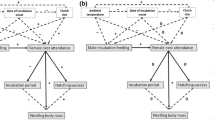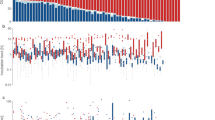Abstract
We found that male small-egged Kajika, Cottus pollux SE sensu Yokoyama and Goto (2005), retained a large volume of urine (approximately, 1 % body weight) in their urinary bladder while nesting under spawning substrate. This increase in urine volume occurred three days after the males were transferred to the nesting tank. Serum 11-ketotestosterone (11-KT) concentrations of males also increased approximately twofold after the males were transferred to the nesting tank. While this increase in the urinary volume was observed only during the reproductive period (late December), the increase in serum 11-KT concentration from the basal levels associated with nesting occurred from the spermatogenic period (from October to mid-December) to the reproductive period (late December). These findings suggest that the urine of nesting males plays a role in reproduction, whereas the increase in serum 11-KT levels may be associated with social status/dominance. The increased urine due to nesting contained an approximately sixfold level of 11-KT compared to the initial control values, suggesting that the urine of nesting male Kajika may have functioned as social signals to females and/or to other males.






Similar content being viewed by others
References
Asahina K, Kambegawa A, Higashi T (1995) Development of microtiter plate enzyme-linked immunosorbent assay for 17α, 20β-21-trihydroxy-4-pregnen-3-one, a teleost gonadal steroid. Fish Sci 61:491–494
Avila VL (1976) A field study of nesting behavior of male bluegill sunfish (Lepomis macrochirus Rafinesque). Amer Midland Natur 96:195–206
Barata EN, Hubbard PC, Almeida OG, Miranda A, Canario AVM (2007) Male urine signals social rank in the Mozambique tilapia (Oreochromis mossambicus). BMC Biol 5:54
Bentley PJ (1998) Comparative Vertebrate Endocrinology, 3rd ed, Cambridge University Press, New York
Borg B (1994) Androgens in teleost fishes. Comp Biochem Physiol 109C:219–245
Chernyaev ZA (1977) Morphoecological features of reproduction and development of sand sculpin Paracottus (Leocottus) kessleri (Dyb.) from Lake Baikal. Vopr Ikhtiol 17:1055–1069
Chernyaev ZA (1979) Reproduction and development of Batrachocottus baicalensis (Dyb.) from Lake Baikal. Vopr Ikhtiol 19:1053–1067
Dorts J, Grenouillet G, Douxfils J, Mandiki SNM, Milla S, Silvestre F, Kestemont P (2012) Evidence that elevated water temperature affects the reproductive physiology of the European bullgead Cottus gobio. Fish Physiol Biochem 38:389–399
Fukui K, Fujii R, Tahara D, Hayakawa Y. Koya Y (2007) Annual changes in gonadal histology and serum profiles of sex steroids in KAJIKA, Cottus sp. SE (small egg type), under rearing conditions. Jpn J Ichthyol 54:173–186
Goto A (1982) Reproductive behavior of a river sculpin, Cottus nozawae. Jpn J Ichthyol 28:453–457
Goto A (1983) Spawning habits and reproductive isolating mechanism of two closely related river-sculpins, Cottus amblystomopsis and C. nozawae. Jpn J Ichthyol 30:168–175
Goto A (1988) Reproductive behavior and homing after downstream spawning migration in the river sculpin, Cottus hangiongensis. Jpn J Ichthyol 34:488–496
Goto A (1994) Land-locking and speciation in diadromous fishes, with special reference to polypatric speciation and sympatric speciation. In: Goto A, Tsukamoto K, Maekawa K (eds) Freshwater fishes migrating between rivers and sea: life-history and evolution. Tokai University Press, Tokyo, pp 222–241
Helvey M (1982) First observations of courtship behavior in rockfish, genus Sebastes. Copeia 1982:763–770
Huertas M, Akmeida OG, Canário AVM, Hubbard PC (2014) Tilapia male urinary pheromone stimulates female reproductive axis. Gen Comp Endocrinol 196:106–111
Kastel PL, Dmitrieva TM, Valeyev RB, Kozlov YP (1992) Sex pheromones of male yellowfin Baikal sculpin (Cottocomephorus grewingki): isolation and chemical studies. J Chem Ecol 18:2003–2010
Keller-Costa T, Lopes OS, Almeida O, Hubbard PC, Iacovella A, Lima M, Barata EN, Canário AVM (2012) Muscular hypertrophy of urinary bladders in dominant tilapia facilitates the control of aggression through urinary signals. Behaviour 149:953–975
Koyama H (1950) Ecological studies of Cottus pollux Günther in Chikuma River. I. On living condition and breeding habits. Bull Japan Soc Sci Fish 16:5–12
Kumagai M, Sugiyama H, Goto A (2013) Polymorphic spawning-nest in a local population of the fluvial sculpin, Cottus nozawae (Teleostei: Cottidae). Ichthyol Res 60:396–400
Kynard BE (1978) Breeding behavior of a lacustrine population of threespine sticklebacks (Gasterosteus aculeatus L.). Behaviour 67:178–207
McBride JR, Van Overbeeke AP (1971) Effects of androgens, estrogens, and cortisol on the skin, stomach, liver, pancreas, and kidney in gonadetomized adult sockeye salmon (Oncorhynchus nerka). J Fish Board Can 28:485–490
Manzon LA (2002) The role of prolactin in fish osmoregulation: a review. Gen Comp Endocrinol 125:291–310
Miura T, Yamauchi K, Takahashi H, Nagahama Y (1992) The role of hormones in the acquisition of sperm motility in salmonid fish. J Exp Zool 261:359–363
Miura T, Higuchi M, Ozaki Y, Ohta T, Miura C (2006) Progestin is an essential factor for the initiation of the meiosis in spermatogenetic cells of the eel. Proc Natl Acad Sci USA 103:7333–7338
Munakata A, Kobayashi M (2010) Endocrine control of sexual behavior in teleost fish. Gen Comp Endocrinol 165:456–468
Natsumeda T (2005) Biotic and abiotic influences on nest-hatching outcome in the Japanese fluvial sculpin, Cottus pollux. Environ Biol Fish 74:349–356
Okada S (1936) Breeding habits of a river sculpin, Cottus pollux Günther. Zool Mag (Tokyo) 48:923–928
Oliveira RF, Almada VC, Canario AVM (1996) Social modulation of sex steroid concentrations in the urine of male cichlid fish Oreochromis mossambicus. Horm Behav 30:2–12
Parikh VN, Clement TS, Fernald RD (2006) Androgen level and male social status in the African cichlid, Astatotilapia burtoni. Behav Brain Res 166:291–295
Pavlov DA, Emel’yanova NG (2007) Features of reproductive biology in two tropical fish species from the family Scorpaenidae. J Ichthyol 47:353–365
Pavlov DA, Emel’yanova NG (2013) Transition to viviparity in the order Scorpaeniformes: brief review. J Ichthyol 53:52–69
Quinitio GF, Takahashi H, Goto A (1988) Annual changes in the testicular activity of the river sculpin, Cottus hangiongensis Mori, with emphasis on the occurrence of aberrant spermatids during spermatogenesis. J Fish Biol 33:871–878
Rodgers EW, Earley RL, Grober MS (2006) Elevated 11-ketotestosterone during paternal behavior in the bluebanded goby (Lythrypnus dalli). Horm Behav 49:610–614
Savage T (1963) Reproductive behavior of the mottled sculpin, Cottus bairdi Girard. Copeia 1963:317–325
Schulz RW, de França LR, Lareyre J-J, LeGac F, Chiarini-Garcia H, Nobrega RH, Miura T (2010) Spermatogenesis in fish. Gen Comp Endocrinol 165:390–411
Scott AP, Liley NR (1994) Dynamics of excretion of 17α, 20β-dihydroxy-4-pregnen-3-one 20-sulphate, and of the glucuronides of testosterone and 17β-oestradiol, by urine of reproductive mature male and female rainbow trout (Oncorhynchus mykiss). Fish Biol 44:117–129
Soin SG, Chepurnov VA (1986) Specific features of structure of additional formations in the urogenital system of some marine fish. Vopr Ikhtiol 26:726–733
Stacey N, Sorensen P (2009) Hormonal pheromones in fish. In: Pfaff DW, Arnold AP, Etgen AM, Fahrbach SE, Rubin RT (eds) Hormones, brain and behavior, Vol. 1 Academic Press, San Diego, pp 639–681
Tahara D, Hatano R, Iwatani H, Koya Y, Hayakawa Y (2010) Annual changes in testicular development and occurrence of parasperm in the male reproductive organs of fourspine sculpin, Cottus kazika. Ichthyol Res 57:62–70
Yamamoto S, Sawamoto Y (1998) Physical environment of the microhabitat of Japanese sculpin (river residence type), Cottus pollux in Chikuma river. Suisanzoshoku 46:231–236
Yambe H, Yamazaki F (2006) Transitions of urine flow rate and kidney-somatic index in mature masu salmon. Fish Sci 72:1048–1053
Yambe H, Kitamura S, Kamio M, Yamada M, Matsunaga S, Fusetani N, Yamazaki F (2006a) L-Kynurenine, an amino acid identified as a sex pheromone in the urine of ovulated female masu salmon. Proc Natl Acad Sci 103:15370–15374
Yambe H, Yamada M, Yamazaki F (2006b) Responses of immature male masu salmon parr to the urine of mature males. Ichthyol Res 53:182–184
Yokoyama R, Goto A (2005) Evolutionary history of freshwater sculpins, genus Cottus (Teleostei; Cottidae) and related taxa, as inferred from mitochondrial DNA phylogeny. Mol Phyl Evol 36:645–668
Acknowledgments
We thank Mr. Kentaro Fukui, Mr. Issei Kawashiro, and Mr. Takuma Higuchi of Gifu University for their laboratory assistance. We also thank Dr. Youichi Hayakawa from the International Christian University for valuable advice regarding this study. This study was supported in part by Japan Society for the Promotion of Science KAKENHI Grant Number 26450277.
Author information
Authors and Affiliations
Corresponding author
About this article
Cite this article
Koya, Y., Fujii, R., Yambe, H. et al. Nesting behavior is associated with increased urinary volume in the urinary bladder during the reproductive period in small-egged Kajika, Cottus pollux SE. Ichthyol Res 63, 59–67 (2016). https://doi.org/10.1007/s10228-015-0475-6
Received:
Revised:
Accepted:
Published:
Issue Date:
DOI: https://doi.org/10.1007/s10228-015-0475-6




